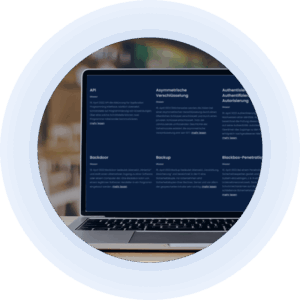![]() Man-in-the-middle attack
Man-in-the-middle attack

“Man-in-the-Middle” bedeutet übersetzt Mittelsmann. Denn bei einem solchen Angriff platziert sich jemand als Mittelsmann zwischen zwei Kommunikationsparteien – ohne ihr Wissen.
Ziel ist, die Kommunikation mitzulesen, eventuell zu verändern und vertrauliche Informationen wie z. B. Passwörter und Login-Daten zu erfahren.
Es gibt unterschiedliche Vorgehensweisen für diese Angriffe. Grundlegend einteilen lassen sie sich in Angriffe, die abzielen auf
Ein auch für Laien gut nachvollziehbares Angriffsmuster ist das Vortäuschen eines öffentlichen WLAN-Zugangs z. B. in Flughäfen, Hotels oder Cafés. Der vermeintliche WLAN-Zugang trägt einen legitim klingenden Namen und zeichnet sich durch ein starkes Signal aus. Aber der gesamte Datenverkehr läuft durch das System des Man-in-the-Middle – auch alle verwendeten Passwörter, Benutzernamen, Bankdaten usw. Wer diesen vermeintlichen WLAN-Zugang nutzt, bemerkt nichts von dem Angriff. Denn der Man-in-the-middle leitet die Daten jeweils an Zieladresse weiter.
Prinzipiell bei jedem Datenaustausch, ganz besonders via Internet.
Auf jeden Fall sollten Sie Man-in-the-Middle-Angriffe vor und bei der Nutzung eines öffentlichen WLAN-Zugangs berücksichtigen.
‘Man-in-the-middle’ means exactly what it says. In this type of attack, someone places themselves between two communicating parties without their knowledge.
The aim is to read the communication, possibly change it and obtain confidential information such as passwords and login details.
There are different methods used for these attacks. They can be broadly divided into attacks that target
One attack pattern that is easy to understand, even for laypeople, is the simulation of public Wi-Fi access, e.g. in airports, hotels or cafés. The supposed Wi-Fi access has a legitimate-sounding name and is characterised by a strong signal. However, all data traffic runs through the man-in-the-middle’s system – including all passwords, user names, bank details, etc. Anyone using this supposed Wi-Fi access will not notice the attack. This is because the man-in-the-middle forwards the data to the destination address.
In principle, during any data exchange, especially via the Internet.
In any case, you should be aware of man-in-the-middle attacks before and when using public Wi-Fi access.